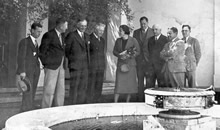
The Great Depression
Finally, in the 1928 election, Curtin was elected as Member for Fremantle. He became a member of the Federal Government, but not of the cabinet, when the ALP won the August 1929 election, called as result of crisis in the Bruce-Page Government when Bruce's Bill to dismantle the Arbitration Court was defeated. [35] But the Scullin Government was barely in office when the Great Economic Depression began.
In mid-1931, the State Premiers and Prime Minister Scullin devised a financial strategy - known as the Premiers' Plan - which involved raising taxes, lowering interest rates, and reducing government spending (including wages and pensions) by 20 per cent.
Curtin and Don Cameron were two Federal Parliamentary Labor Party members who opposed the Plan because it did not implement 'equality of sacrifice' as claimed, with Curtin declaring in Parliament that party endorsement of the Plan would bring about the 'demoralisation of the Labor movement'. In particular, Curtin was 'opposed to the plan in its entirety' because:
... the variations of interest rates are contingent upon my acquiescence in the reduction of payments to old age, invalid, and war pensioners, and because implicit in the plan is an abandonment of the whole conception of the Labour movement in regard to the reconstruction of society ... [T]he plan ... leaves untouched the top-heavy political system of this country ... [I]n effect it says to me, 'Go out and justify the taking of 2s. 6d. a week from the income of an old age pensioner', while at the same time it is proposed that we shall continue to maintain the panoply of six sovereign States, with six agents-general, six governors, and all the pomp and ceremony of thirteen chambers connected with the political mechanism of this country... [36]
At the end of 1931, Labor lost the federal election and Curtin lost the seat of Fremantle, depressed, disillusioned and unemployed. Almost immediately, he wrote to Henry Boote, seeking a position doing something for the Party in the Eastern States. He wrote:
My feeling is that the real effective decisions of the Labor Movement are made in the East and that for all practical purposes, WA does not count in the formulation of Labor policy... [37]
A job did not eventuate for Curtin in the Eastern States, and in 1934, he was re-elected to Fremantle. This time, his opponent was Florence Cardell-Oliver (who later entered State politics and became Australia's first female cabinet member). Curtin won the seat with a majority of 'just over a thousand votes'. [38]
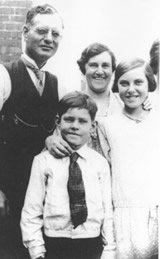 John and Elsie Curtin with their children,
John and Elsie Curtin with their children,
taken in Melbourne, 1928.
Records of the Curtin Family.
JCPML00004/12
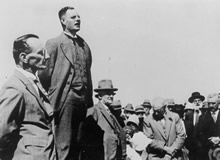 John Curtin speaking at the opening of South Beach, Fremantle, December 1928.
John Curtin speaking at the opening of South Beach, Fremantle, December 1928.
Records of the Curtin Family. JCPML00376/160
Leadership of the ALP
Back in Canberra, Curtin's caucus colleagues elected him to the Opposition front bench and to the FPLP Executive. But few foresaw his speedy elevation to Party Leadership. Curtin was reportedly 'stunned' when he heard that his old anti-conscription colleague, E.J. Holloway, was heading a caucus group pushing to make him Leader of the Party, with the support of the Member for Kalgoorlie, 'Texas' Green. On 1 October 1935, Curtin won the ballot from the other main contender, Francis Forde, by one vote - ironically that of Maurice Blackburn, Frank Anstey's successor in the seat of Bourke, whom Curtin had described as 'a blancmange' who brought 'no trophies' to the party while 'eagerly clutching at them' himself. [39] The Western Australian State Executive responded swiftly with sincerely expressed congratulations. Replying to ALP Secretary Percy Trainer, Curtin summed up his role in the Western Australian Labor movement:
For years I have been either a member or an officer of the State Executive and to the utmost of my ability, I have endeavoured to interpret what would be the reasonable view of the majority of its members. It is, therefore, with feelings of deep satisfaction that your message is received as giving the view that whatever may have been the differences in the points of view between myself and individual members from time to time, these are of little consequence compared with the broad general unity of thought that has marked the State Executive as a body and myself as its officer for so many years.
I have no great sense of personal ambition, and I have never had any ... The Western Australian Labor Movement has given me much, and I have given to it the best of which I was capable, yet I feel I am indeed its debtor and that I have gained more than I have given. [40]
Possibly, Curtin was selected because of the very factors that might have appeared to militate against him: his absence from the House of Representatives and his isolation in Western Australia during the split in NSW that resulted in the Lang Labor group. But he also was seen as 'a more intelligent and inspiring leader' than Frank Forde, 'with a power of oratory that had few equals in the parliament'. Also Curtin had opposed the Premiers' Plan, whilst Forde had supported it. [41] Curtin inherited a Labor Party depleted financially and ideologically, and split into two warring factions in New South Wales. From the outset, he clearly understood that his task was to unite and build up the party, aiming to return it to Federal Government. To achieve this end, he toured the country by train, meeting and talking with as many members in as many places as possible.
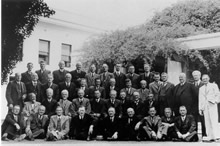 Federal Labor Party, 1936.
Federal Labor Party, 1936.
Records of the Curtin Family.
JCPML00376/152
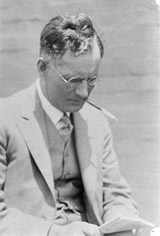 Leader of the Opposition, John Curtin.
Leader of the Opposition, John Curtin.
October 1935.
Records of the Curtin Family.
JCPML00376/135
Party Unity
The first step was to heal the split between 'Lang' Labor and the ALP in NSW, where they held nine seats after the 1934 election, compared with 18 House of Representatives seats held by the ALP. 'Lang' Labor was the name given to a group of supporters of NSW Premier Jack Lang, whose controversial Lang Plan (1931) had advocated that the Australian government suspend payments on overseas loans, reduce interest on internal government loans to 3 per cent and abandon the gold standard. [42] Despite Lang's sacking as Premier, on Friday 13 May1932 [43], his influence remained powerful and pervading in the NSW Branch. As Theodore wrote to Curtin in October:
There is little sign of returning sanity in NSW. The Lang gang still rules in the unions, and rules by coercion and through hand-picked executives and conferences, but, it must be confessed, it rules with the overt concurrence of the mass of the unionists. To go out and attempt to win the country in the face of these facts would be utterly futile. [44]
In January 1935, the Victorian State Conference recognized Lang Labor as the 'true' Labor Party in NSW. [45] Like Theodore, Curtin knew that Labor had no chance of regaining Federal Government without the NSW Branch. Accordingly, one of his first tasks as Leader was to arrange a Special Unity Conference in Melbourne in February 1936, followed by a federal conference in July at which the ALP rescinded its 1931 motion expelling Lang and his followers from the Party. Members of the Lang group were invited to rejoin the Federal Caucus, which some did [46], but it was not until 1937 that the State branches all accepted the supremacy of the federal executive. [47] The ALP had compromised, but Curtin's efforts to reunite the Party were eventually rewarded, although problems persisted with the Langites until well after the beginning of the war. [48]
 "Lang is right" lapel badge, 193?
"Lang is right" lapel badge, 193? Records of the Australian Labor Party
New South Wales Branch.
JCPML00842/1
![Labor Day Procession ["Make Jack Curtin Prime Minister" banner], 1937. JCPML00568/10/2](pics/JCPML00568_10_2s.jpg) Labor Day Procession ["Make Jack Curtin Prime Minister" banner], 1937.
Labor Day Procession ["Make Jack Curtin Prime Minister" banner], 1937.
Records of Bobbie Oliver.
JCPML00568/10/2
Tensions in Europe
As the 1930s progressed, the long-term impact of World War I was making itself felt with the rise of aggressive regimes in Germany and Italy. Gradually, the hopes that the 1914-18 had been the war to end all wars disappeared as conflicts flared. During the Munich crisis of 1938, while the major European powers argued over 'spheres of influence' in Czechoslovakia, the Federal ALP maintained an isolationist stance. Curtin asked the government, now led by former ALP member Joseph Lyons, for an assurance that they would not automatically commit Australia if Britain declared war on Germany. In Parliament, he said: 'The wars of Europe are a quagmire, in which we should not allow our resources, our strength, our vitality to be sunk almost ... to the point of complete disappearance'. Australians' first duty, Curtin declared, was to their own nation; therefore, 'no men must be sent out of Australia to participate in another war overseas'.
Nevertheless, when Menzies, Lyons' successor as Prime Minister, committed Australia to war without consulting even his Cabinet, the ALP did not challenge his decision. [49]
Leading the Opposition in war time
As Leader of the Opposition during wartime, Curtin believed in supporting the Government in its war effort while maintaining a full Parliamentary Opposition, capable of criticising the Menzies administration when necessary. In Parliament on 6 September, 1939, he strongly opposed attempts to form a national government consisting of all the political parties, because he believed that a functioning Opposition was essential to the proper conduct of the war.
In June 1940, the Federal Labor Conference altered its defence policy to express its 'complete and indissoluble unity with the Allies in war'. The second plank of the platform stated that 'the entire resources of Australia should be under the control of the Commonwealth Government', but many Federal Labor Members opposed amending the National Security Act to grant the Government far reaching powers. [50] The Conference supported maintaining a separate party in Opposition, and urged that ALP representatives be included in a National War Council to advise the government in the conduct of the war and in preparing for post-war reconstruction. It took Curtin several months to persuade Menzies to establish a joint War Council, which enabled the Federal Parliamentary Labor Party to influence the resolution of industrial disputes involving the coal miners and waterside workers. [51]
The first Federal election of the war took place on 21 September 1940. Curtin opened Labor's campaign at Perth on 28 August, but neglected Fremantle while campaigning zealously around Australia, and barely retained his seat. His United Australia Party [UAP] opponent, F.R. Lee, lost by only 641 votes. [52] Labor polled better than in the previous election, resulting in a Parliament in which the UAP/Country Party Coalition and Labor each held 36 seats. The balance of power was held by two Independents. Immediately, the new government was in difficulties. While the Federal Budget was being debated in the House of Representatives, Curtin was under pressure from Caucus to exploit the precarious situation of the UAP Government.
Curtin accepted the Prime Minister's challenge on the budget and stated that he was prepared to go to another general election. Menzies then invited him to confer, and with ALP support, Curtin was able to bring about a number of concessions without compromising the Party. These included raising the threshold of exemption under the Federal Income Tax which 'spared the great mass of the working class', and having the proposed soldiers' pay increase converted to a family allowance of seven shillings a week for the dependents of members of the armed forces who were serving in Palestine. Curtin had also secured a promise that the old age pension would not be reduced below a guinea a week, and that it would be subject to a quarterly adjustment based on present purchasing power compared with that in 1939. But Evatt, Brennan, Ward and Calwell, and others continued to oppose Menzies' budget and urged Curtin to bring the government down so that Labor could take office. This occurred at the end of the year when the two Independents deserted the government and crossed the floor of the House. [53]
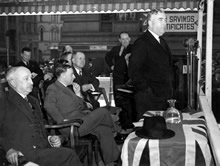 Robert Menzies at Sydney opening of War Savings Week, 14 October 1940.
Robert Menzies at Sydney opening of War Savings Week, 14 October 1940.
Original held by National Library of Australia, MS 4936 Series 9, box 342 1940's-1950's, Folder 6. JCPML00916/12
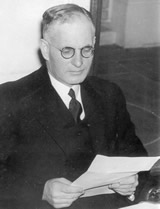 Framed photograph of John Curtin ca 1941.
Framed photograph of John Curtin ca 1941.
Records of Thelma MacKinnon.
JCPML00752/1
